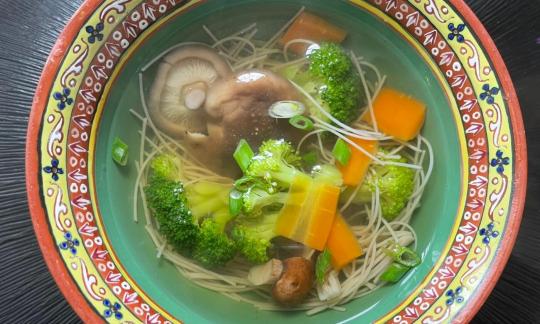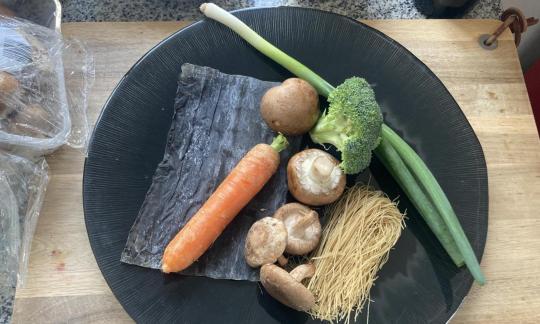Kombu Dashi with Shiitake Mushrooms, Carrot and Noodles
vegan
Ingredients (for servings, )
Equipment
- vegetable peeler
- stove
- saucepan
Type of preparation
- chop or grind
- soak
- season to taste
- peel
- simmer
Preparation
preparation the day before
Soak kombu seaweed overnight.preparation
Heat the soaked kombu seaweed together with the soaking water. Just before it boils, reduce the heat and let it simmer for about 15 minutes.In the meantime, clean the shiitake mushrooms and button mushrooms. Peel the carrot and cut into thin slices or strips. Divide the broccoli into small florets. Cut the spring onion into rings.
Finishing the Kombu Dashi
Remove the kombu seaweed from the broth. Add the rice noodles and vegetables (except the spring onion) and simmer for another 5 minutes.
Season with soy sauce and serve sprinkled with spring onions.We used whole grain rice noodles, but soba noodles also work very well.
You can also use miso paste instead of soy sauce for seasoning.Nutrient profile: The supposedly extremely high iodine content is actually much lower because the kombu seaweed is removed from the dish before consumption.
|
Nutritional Information per person
Convert per 100g
|
2000 kcal | |
|---|---|---|
| Energy | 110 kcal | 5.5% |
| Fat/Lipids | 0.56 g | 0.8% |
| Saturated Fats | 0.08 g | 0.4% |
| Carbohydrates (inc.dietary fiber) | 23 g | 8.6% |
| Sugars | 3.8 g | 4.2% |
| Fiber | 4.2 g | 16.8% |
| Protein/Albumin | 4.4 g | 8.9% |
| Cooking Salt (Na:234.6 mg) | 596 mg | 24.8% |
| Essential micronutrients with the highest proportions | per person | 2000 kcal | |
|---|---|---|---|
| Min | Iod, I (Jod, J) | 7'398 µg | 4'932.0% |
| Vit | Vitamin K | 107 µg | 143.0% |
| Vit | Vitamin C (ascorbic acid) | 44 mg | 55.0% |
| Vit | Vitamin A, as RAE | 287 µg | 36.0% |
| Vit | Vitamin B9, B11 (Folate, as the active form of folic acid) | 63 µg | 32.0% |
| Elem | Potassium, K | 592 mg | 30.0% |
| Sodium, Na | 235 mg | 29.0% | |
| Prot | Threonine (Thr, T, irreversibly transaminated) | 0.20 g | 22.0% |
| Min | Copper, Cu | 0.21 mg | 21.0% |
| Prot | Tryptophan (Trp, W) | 0.05 g | 19.0% |
Detailed Nutritional Information per Person for this Recipe
The majority of the nutritional information comes from the USDA (US Department of Agriculture). This means that the information for natural products is often incomplete or only given within broader categories, whereas in most cases products made from these have more complete information displayed.
If we take flaxseed, for example, the important essential amino acid ALA (omega-3) is only included in an overarching category whereas for flaxseed oil ALA is listed specifically. In time, we will be able to change this, but it will require a lot of work. An “i” appears behind ingredients that have been adjusted and an explanation appears when you hover over this symbol.
For Erb Muesli, the original calculations resulted in 48 % of the daily requirement of ALA — but with the correction, we see that the muesli actually covers >100 % of the necessary recommendation for the omega-3 fatty acid ALA. Our goal is to eventually be able to compare the nutritional value of our recipes with those that are used in conventional western lifestyles.
| Essential fatty acids | per person | 2000 kcal |
|---|---|---|
| Alpha-Linolenic acid; ALA; 18:3 omega-3 | 0.02 g | 1.0% |
| Linoleic acid; LA; 18:2 omega-6 | 0.13 g | 1.0% |
| Essential amino acids | per person | 2000 kcal |
|---|---|---|
| Threonine (Thr, T, irreversibly transaminated) | 0.20 g | 22.0% |
| Tryptophan (Trp, W) | 0.05 g | 19.0% |
| Valin (Val, V) | 0.25 g | 15.0% |
| Isoleucine (Ile, I) | 0.16 g | 13.0% |
| Phenylalanine (Phe, F) | 0.18 g | 12.0% |
| Leucine (Leu, L) | 0.26 g | 11.0% |
| Lysine (Lys, K, irreversibly transaminated) | 0.20 g | 11.0% |
| Methionine (Met, M) | 0.07 g | 7.0% |
| Vitamins | per person | 2000 kcal |
|---|---|---|
| Vitamin K | 107 µg | 143.0% |
| Vitamin C (ascorbic acid) | 44 mg | 55.0% |
| Vitamin A, as RAE | 287 µg | 36.0% |
| Vitamin B9, B11 (Folate, as the active form of folic acid) | 63 µg | 32.0% |
| Vitamin B2 (Riboflavin) | 0.24 mg | 17.0% |
| Vitamin B7 (Biotin, ex vitamin H) | 8.5 µg | 17.0% |
| Vitamin B5 (Pantothenic acid) | 0.98 mg | 16.0% |
| Vitamin B6 (pyridoxine) | 0.20 mg | 15.0% |
| Vitamin B3 (Niacin) | 2.3 mg | 14.0% |
| Vitamin B1 (Thiamine) | 0.11 mg | 10.0% |
| Vitamin E, as a-TEs | 0.72 mg | 6.0% |
| Vitamin D | 0.11 µg | 2.0% |
| Vitamin B12 (Cobalamin) | 0.01 µg | < 0.1% |
| Essential macroelements (macronutrients) | per person | 2000 kcal |
|---|---|---|
| Potassium, K | 592 mg | 30.0% |
| Sodium, Na | 235 mg | 29.0% |
| Phosphorus, P | 116 mg | 17.0% |
| Magnesium, Mg | 41 mg | 11.0% |
| Calcium, Ca | 80 mg | 10.0% |
| Essential trace elements (micronutrients) | per person | 2000 kcal |
|---|---|---|
| Iod, I (Jod, J) | 7'398 µg | 4'932.0% |
| Copper, Cu | 0.21 mg | 21.0% |
| Manganese, Mn | 0.30 mg | 15.0% |
| Selenium, Se | 6.8 µg | 12.0% |
| Iron, Fe | 1.2 mg | 9.0% |
| Zinc, Zn | 0.81 mg | 8.0% |
| Fluorine, F | 230 µg | 7.0% |
This vegan kombu dashi with shiitake mushrooms, carrot, broccoli and whole grain rice noodles is a classic Japanese broth.
Nutrient profile: The supposedly extremely high iodine content is actually much lower because the kombu seaweed is removed from the dish before consumption.
Kombu seaweed: Kombu seaweed (mostly dried Japanese leaf kelp) is a brown seaweed and is popular in Asia. It is good for seasoning soups.
Shiitake mushrooms: Shiitake mushrooms are the second most cultivated edible mushrooms in the world. They can be eaten raw or cooked. Shiitake mushrooms give the dish a characteristic mushroom flavor and have the taste quality umami (umami taste). Umami is created by the natural glutamate they contain and activates special taste receptors on the tongue. Shiitake mushrooms are available fresh or dried in every well-stocked supermarket.
Dashi: Dashi is an indispensable basic ingredient in Japanese cuisine. It is a clear broth and its umami aroma gives every recipe a distinctive flavor. It intensifies the natural flavors of the ingredients cooked in this broth. Dashi is the most important basic ingredient for things like miso soups and noodle soups.
Traditionally made from bonito flakes (fish), kombu and water, this vegan version is very easy to prepare.
This fish-free dashi broth is not a new development. In fact, it has been around for about 1,500 years. With the arrival of Buddhism in Japan, a vegan version of the broth was developed by using shiitake mushrooms instead of bonito fish. Their high proportion of natural glutamic acid makes them a good alternative to bonito flakes.
Miso paste: You can also use miso paste instead of soy sauce for seasoning.
Vary the vegetables : You can use only some of the vegetables or other vegetables as well.
You can replace the noodles with others - e.g. soba noodles, or simply leave them out altogether.






